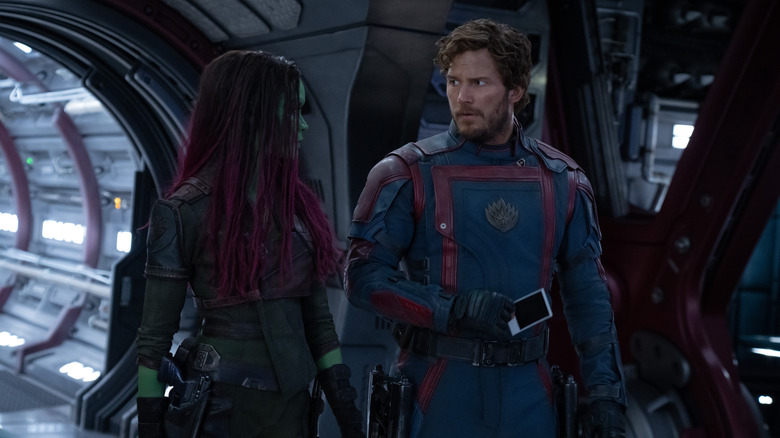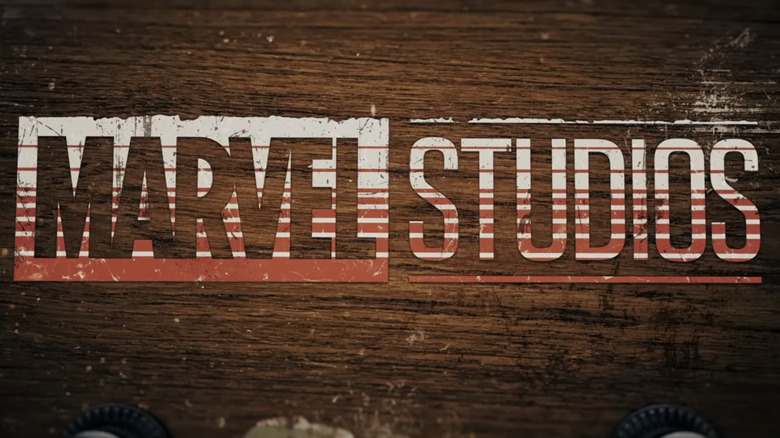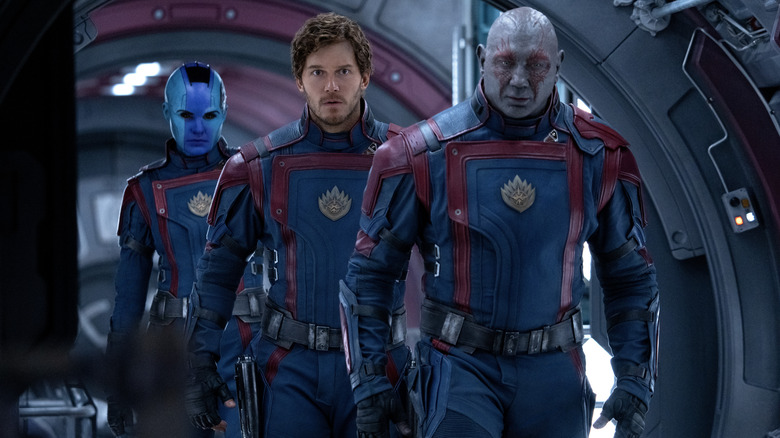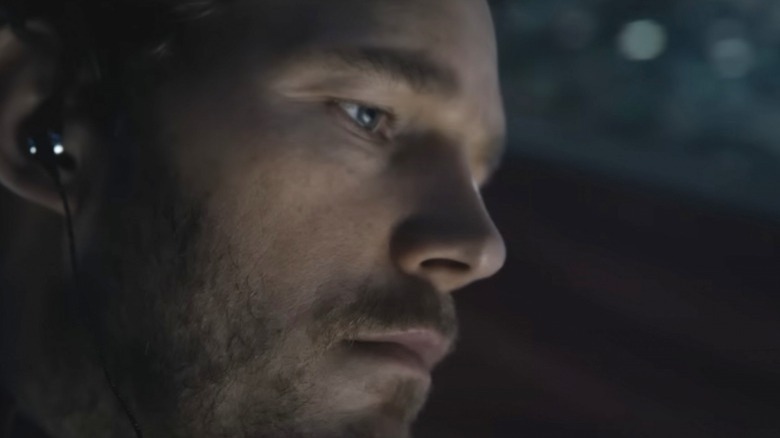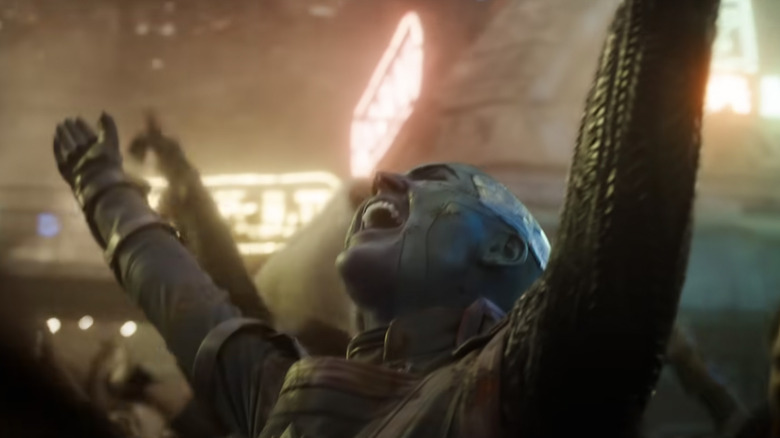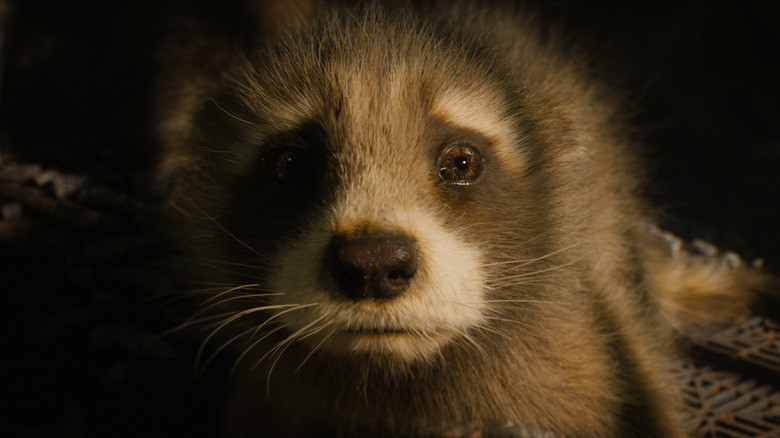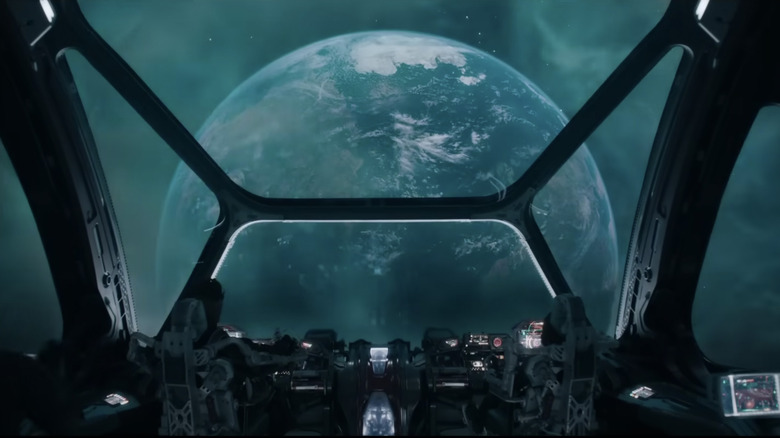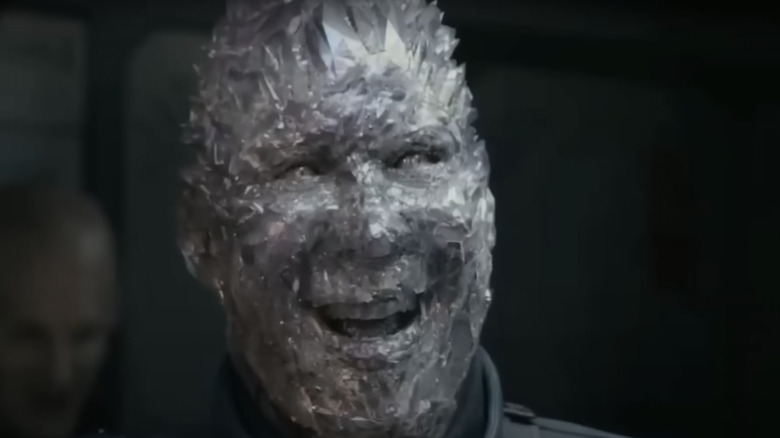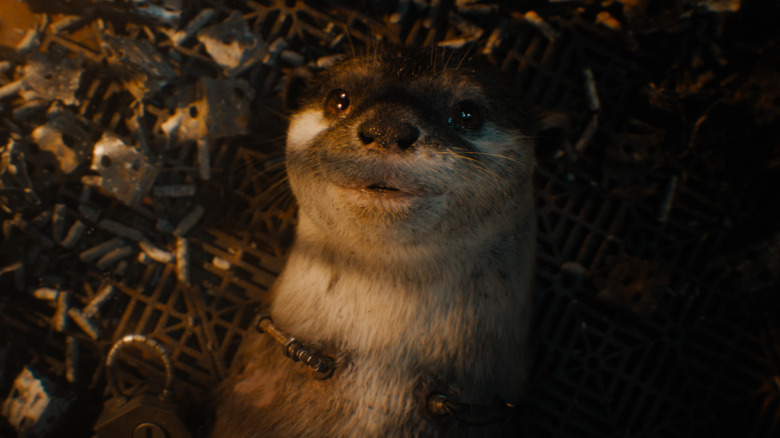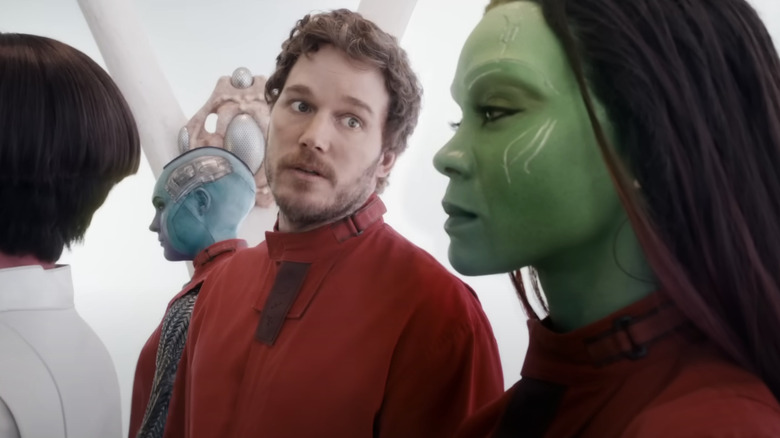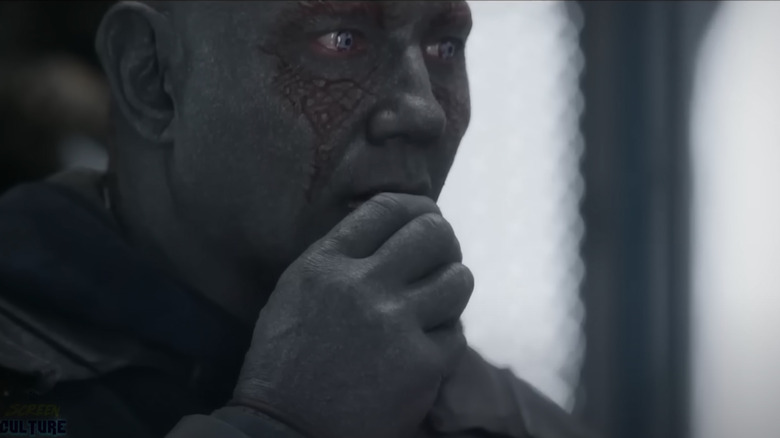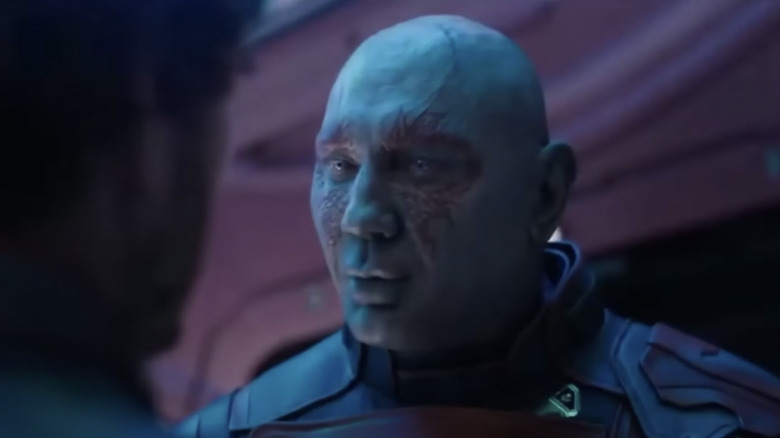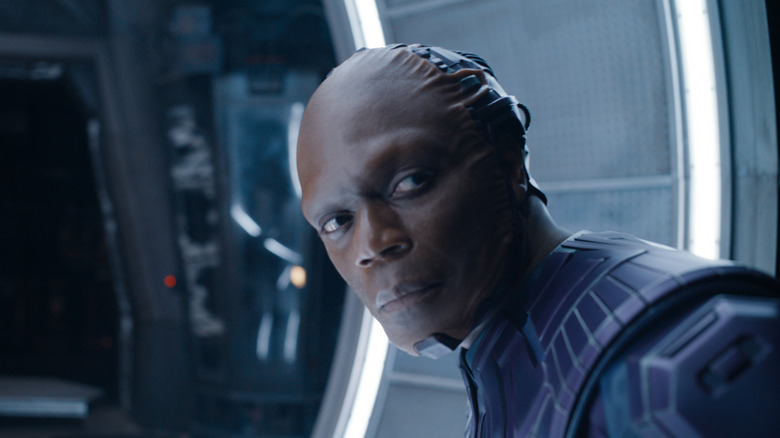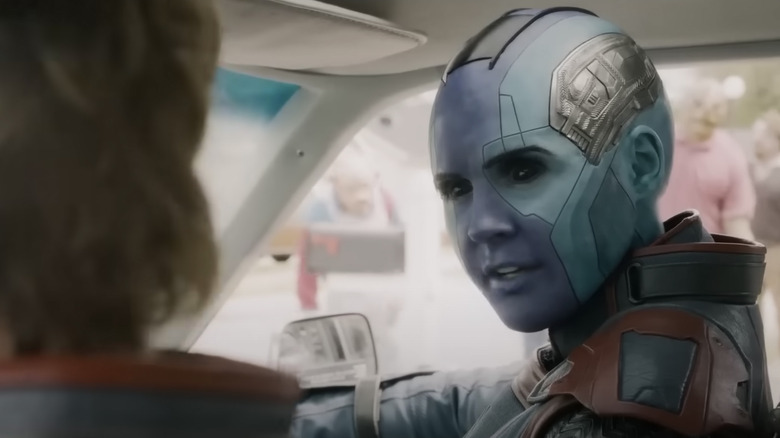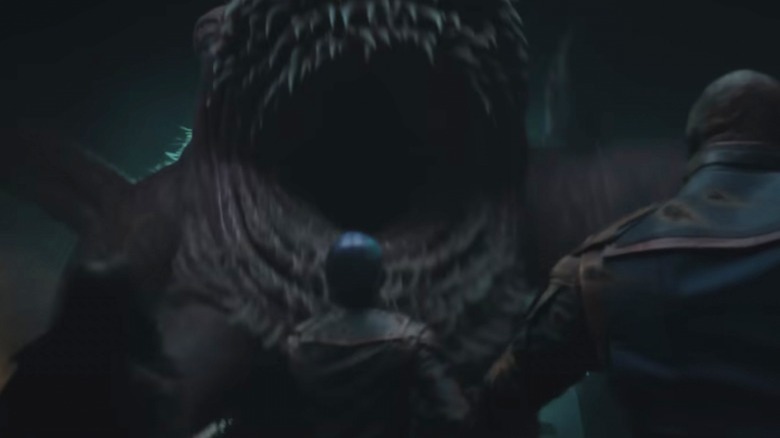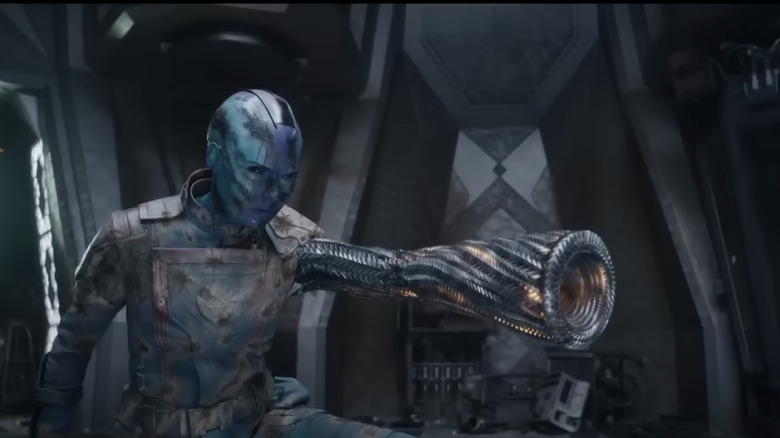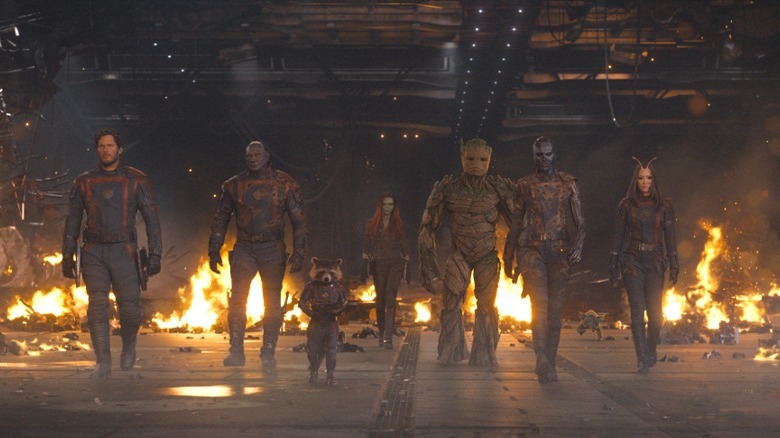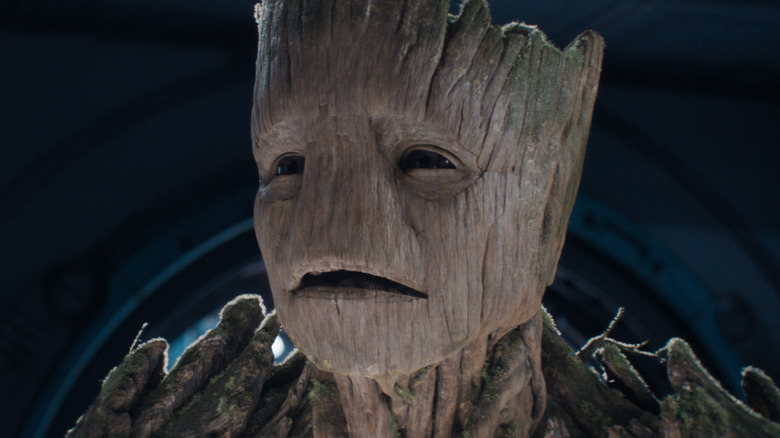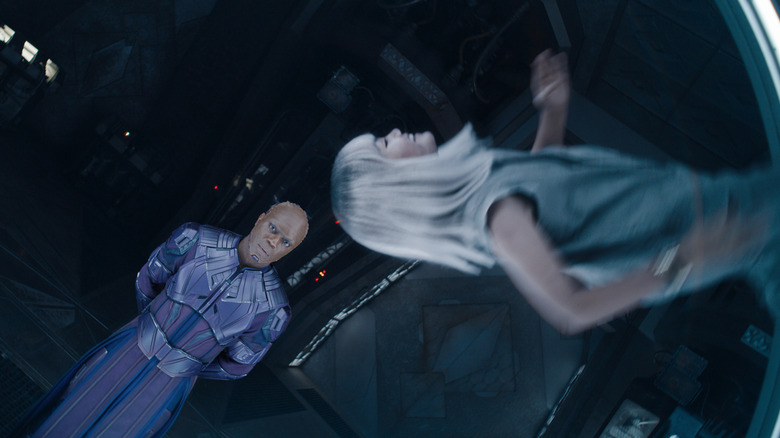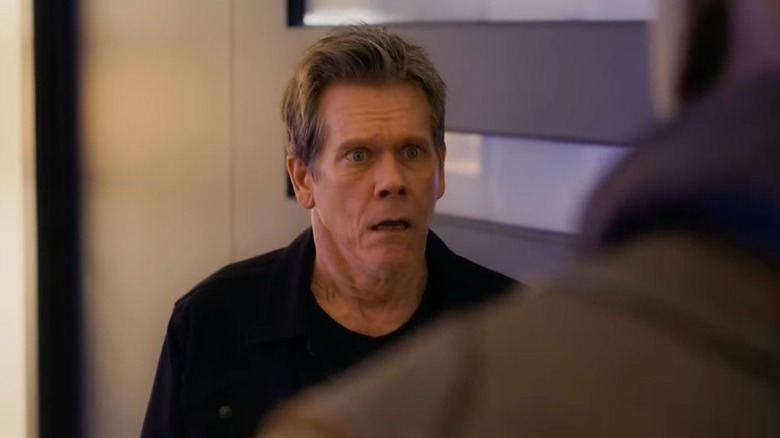Easter Eggs And References You Missed In Guardians Of The Galaxy Vol. 3
The Marvel Cinematic Universe's "Guardians of the Galaxy" era has drawn to a close. The third installment is an irreverent yet meaningful send-off to one of the MCU's strongest tentpoles. Though a last-second title card promises that the legendary Star-Lord (Chris Pratt) will return, this is, for all intents and purposes, goodbye to the Guardians as we've known them for the last nine years. The motley crew of space do-gooders-and-badders played well with other Marvel characters, but were also an entity unto themselves, thanks to writer-director James Gunn's authorial voice and the cast and crew's shared vision.
That vision borrows not only from comic books but from '80s pop culture (especially pop music), sci-fi storytelling tropes, and much more. Because of that, and because Gunn's all too happy to hide Easter eggs in his projects, the "Guardians" films have even more reference points than the average Marvel Studios movie... and that's really saying something. With three films and a holiday special, the franchise is nothing if not specific. Where other superhero properties might go for broad appeal, Gunn and the Guardians go for broke with idiosyncratic characters, quirks, twists, and running gags, and they give fans credit that they'll come along for the ride.
Since 2014, they have, which means there are even more callbacks. allusions, and other fun details to be found this time around. The Easter eggs and references in "Guardians of the Galaxy Vol. 3" are both Marvel-related and not, and span from the completely frivolous to the spiritual and existential. These are the ones you might have missed as you were laughing and crying your way through.
An all GotG themed Marvel intro
Back in 2008, when there was only one movie in the Marvel Cinematic Universe, that movie — "Iron Man" — opened with an animated intro in which the pages of a comic book flipped, eventually revealing the Marvel Studios logo. As more and more films got added to the franchise, those intros began to feature more Marvel characters and, eventually, pull quotes, live-action scenes from the movies, and the theme music that fans know and love.
But every once in a while, Marvel Studios gets creative with its opening title sequence, and when they do, it's usually to mark an occasion. For example, the "Werewolf by Night" credits were styled to mimic classic black-and-white monster movies and to usher in the MCU's first special presentation, while the "Black Panther: Wakanda Forever" opening was a tribute to the late Chadwick Boseman.
"Guardians of the Galaxy Vol. 3" is both the final installment in one of the MCU's most popular mini franchises and James Gunn's last collaboration with Marvel. This time, the Marvel Studios introduction is entirely "Guardians of the Galaxy" themed, with images and quotes from the previous installments. Similarly, the logo that's being used in the marketing is designed to look like it's playing on Peter Quill's vintage dashboard. Volumes 1 and 2 did not have unique intros and "The Guardians of the Galaxy Holiday Special" was preceded by a slightly altered intro, set to Christmas music, in which various Marvel characters are decked out in Santa hats, snow is falling, and string lights adorn the Marvel Studios font.
Comic-accurate super suits
The Guardians of the Galaxy first appeared in Marvel Comics in 1969, though they barely resemble the team that makes up the Guardians in the MCU. The source material from the films mainly comes from storylines that begin in 2008, when Star-Lord forms a group comprised of Rocket Raccoon (Bradley Cooper), Groot (Vin Diesel), Gamora (Zoe Saldaña), Drax (Dave Bautista), Phyla-Vell (who we'll get to), and Adam Warlock (Will Poulter).
The first two "Guardians of the Galaxy" films may have borrowed characters and plot points, but they gave Star-Lord and his associates new-fangled outfits that were meant to relay information about their personalities. The MCU's Peter Quill was designed to look like a cross between a cowboy and a rockstar, with the swagger of both. But for the final film in the trilogy, the team is back in their comics-accurate suits. The leathery red and blue uniforms with the metallic emblem on the chest very closely adhere to the appearance of the 2008 artwork.
The costumes also serve a practical purpose. Dave Bautista has expressed discomfort about playing the physically impressive and often shirtless Drax into his 50s, and though the character canonically is covered with red tattoos (and has sensitive nipples), he's suited up to match his squad in "Guardians of the Galaxy Vol. 3," which allowed Bautista to avoid hours' worth of painstaking body makeup and to relax a little about the state of his physique. Similarly, Drax wears a vest followed by an ugly Christmas sweater in the holiday special, which was filmed at the same time.
Zune tunes
Music is deeply symbolic in the "Guardians of the Galaxy" movies. Not only are needle drops specifically chosen to add meaning to their moments, the very idea of music as a gift is central to the trilogy's theme. Quill's mom makes him his Awesome Mixes Vol. 1 and 2 in the first film, which he plays on his Walkman until Ego (Kurt Russell) destroys it near the end of the sequel.
As that movie draws to a close, Kraglin (Sean Gunn) gives Quill one last present from who became his father figure, Yondu (Michael Rooker) — a digital music player from the early 2000s and Microsoft's version of the iPod, which can hold more (and modern) music. This Zune lets the music play in-world and whatever Peter (or Rocket, or Gamora) is listening to is what the audience hears as well. The Zune Yondu gave to Quill is loaded up with tracks that span from Bruce Springsteen's 1978 hit, "Badlands," to Florence + the Machine's 2008 track, "Dog Days are Over."
There are Easter eggs within the tracklist as well. Whether "Guardians of the Galaxy Vol. 3" producers knew it or not, the Beastie Boys' "No Sleep Till Brooklyn" appears in both of Chris Pratt's current theatrically released films, including "The Super Mario Bros. Movie." In the mid-credits stinger, Rocket mentions that his favorite song is "Come and Get Your Love," which is the tune we hear when we first meet Quill rocking out to his Walkman on Morag. Music, and this Zune in particular, are so important to Star-Lord that he very nearly dies trying to save it in the vacuum of space in "Vol. 3."
Only idiots dance
Music and dancing go together like peanut butter and jelly, so it makes sense that music lover Peter Quill would idolize Kevin Bacon in "Footloose" and use the power of dance to defeat Ronan in "Guardians of the Galaxy Vol. 1." And it makes sense that the act of dancing would be just as important, symbolically, to the "Guardians" franchise as is the music that accompanies it. When the Guardians first assemble, Quill is the only member who feels comfortable moving and grooving. Baby Groot eventually gives in to the rhythm, but everyone else is reluctant.
In the second film, Drax tells Star-Lord that he fell for his late wife because she was the only woman not dancing at a gathering. "She wouldn't even tap her foot," he fondly remembers. "One might assume she was dead." He dissuades Quill from pursuing Gamora because he says there are two types of people — those who dance and those who don't — and Gamora's not a dancer.
But Quill teaches Gamora to dance on Ego's planet, and soon they confess their love for each other. In "Guardians of the Galaxy Vol. 3" Drax again insists, "Only idiots dance." Until the very end of the third film, dancing is meant to stand for silliness while not dancing is meant to indicate self-seriousness. But after the Guardians rescue the captives from the High Evolutionary's (Chukwudi Iwuji) ship and return to Knowhere, music plays and everyone — including Drax and Nebula (Karen Gillan) — throws up their arms and starts to boogie. This touching moment symbolizes not only that the Guardians are all true friends, but that there's room for frivolity even when doing life-and-death work.
89P13
The fact that Rocket Raccoon is the High Evolutionary's designated test subject 89P13 is so prominent in "Guardians of the Galaxy Vol. 3," we can't really call it an Easter egg. But some savvy fans might remember that those numbers and letters appear elsewhere in Rocket's story. Back in "Vol. 1" when he, Groot, Peter Quill, and Gamora are arrested after their three-way melee on Xander, the Nova Corps identify him during "The Usual Suspects" inspired prison lineup sequence with the same alphanumeric code: 89P13. That graphic also includes his rap sheet (theft, arson, mercenary activity, biting, 22 escapes) and his associates (Groot and Lylla). We finally get to meet Lylla Otter (Linda Cardellini), who is his love interest in the comics, in "Vol. 3," where she changes her name from 89Q12.
In the context of the story, Rocket's subject code indicates that he's part of batch 89 of experimented-upon animals. That group also includes his and Lylla's pals, Teefs (who goes by Wal Rus in the comics) and Floor (probably a riff on Blackjack O'Hare). Sadly, batch 89 was the last imperfect enough to be kept out of the High Evolutionary's supposedly utopian Counter-Earth, after a juvenile Rocket's unintentional troubleshooting resulted in batch 90's success. The P could be an abbreviation for the raccoon's scientific name, Procyon Lotor, and the 13 could merely mean that he's the 13 animal in the test group, though we wouldn't put it past James Gunn to have hidden another secret message in there somewhere.
Coordinates for the Orgascpe and Counter-Earth
Speaking of secret messages, a collection of devoted fans, Easter egg hunters, and codebreakers have been working on solving a big one that James Gunn himself has been teasing for years. The writer-director has seemingly confirmed that some sleuths, like New Rockstar's Eric Voss, have gotten close. That theory has to do with Peter Quill's mother, Meredith, possibly having a larger role to play in the MCU's wider story, and evidence for it is a mural on Morag and a word — Eternity — uttered by Peter when Ego shows him a vision of his true purpose.
Elsewhere on the internet, theorizers have been busy translating the coordinates that appear under the names of planets in the "Guardians of the Galaxy" movies. So far, those partially-cracked codes gave away spoilers for the second and third films such as Meredith's cancer at the hand of her former lover Ego and the fact that Herbert Wyndham or the High Evolutionary would be doing experiments in a biomedical clinic.
"Guardians of the Galaxy Vol. 3" takes audiences to two new locations: the Orgoscope and Counter-Earth. Sure enough, there are new sets of coordinates underneath the names of those celestial bodies. It doesn't necessarily follow that they'd function as spoilers, since "Vol. 3" is the last in this trilogy and Gunn won't be involved in more MCU movies. The more likely scenario is that they'll provide the enterprising fans who finally decipher them with a missing piece of information that either completes the infamous Easter egg or adds context to whatever it turns out to be.
Returning characters
Just as the MCU keeps expanding, so too does the roster of characters who've appeared in the franchise to end all franchises. The Guardians have added Mantis (Pom Klementieff), Kraglin, Nebula, and Cosmo (Maria Bakalova) to their ranks, and the movies had added some familiar faces and voices to the cast. "Guardians of the Galaxy Vol. 3" doesn't feature any big-name cameos from other MCU properties. There's no surprise appearance by, say, Thor or Doctor Strange. That's probably because "Vol. 3" is more of a "Guardians" movie than an MCU movie, meant to be a worthy sendoff for James Gunn and the group as we've known it for the last three films. Instead, the cameos that we do get are Guardian-centric and mostly pretty effective.
Michael Rooker makes a brief appearance when Yondu speaks to Kraglin from beyond the grave and The Broker from "Vol. 1" and Howard the Duck, who had a cameo in "Vol. 2" can both be spotted playing games of chance in "Vol. 3." In one of the sequel's many post-credits scenes, we see disparate factions of Ravagers reassemble. These original Guardians from the comics get to be in the movie proper this time.
Sylvester Stallone is back as Stakar Ogord, as is Michael Rosenbaum as Martinex (the Ravager with the skull of crystalized silicon), Krugarr (the red fishy sorcerer who conjures a laugh-cry emoji), and Mainframe (the robot head), voiced by Miley Cyrus in "Vol. 2" and legendary voice actor Tara Strong in "Vol. 3." Missing, however, are Michelle Yeoh's Aleta Ogord and Ving Rhames' Charlie-27. James Gunn voices Lambshank, the hideously deformed experiment that Mantis frees from a cell.
Actors playing more than one MCU role
Some fans might remember that Michelle Yeoh also showed up in "Shang-Chi and the Legend of the Ten Rings" as Shang-Chi's aunt, Ying Nan, who resides in and protects Ta Lo. But she's hardly the first actor who's had the good fortune to portray multiple MCU characters. There are several just in "Guardians of the Galaxy Vol. 3." Lylla Otter is voiced by Linda Cardellini, who's played Hawkeye's wife, Laura Barton, in three films and a TV series, and the High Evolutionary's War-Pig is voiced by Judy Greer. She also plays Scott Lang's ex-wife, Maggie, in the first two "Ant-Man" movies.
Sean Gunn, who's the younger brother of James Gunn, plays Kraglin but also performs Rocket Raccoon physically on set. Nathan Fillion, the longtime collaborator, and friend of Gunn, was the voice of Monstrous Inmate in "Vol. 1," and he has a larger part in "Vol. 3" as Master Karja, the sentry foreman on the Orgoscope. Mikaela Hoover was Nova Prime's Assistant in "Vol. 1" and voices the rabbit Floor this time around. Tara Strong, who provides vocals for Mainframe, does the same for Miss Minutes in "Loki."
Gunn also dipped into the well over at DC in casting "Vol. 3." These actors aren't taking up two MCU roles, but they do have a foot in two comic worlds. Daniela Melchior, who starred in "The Suicide Squad," is Ura the OrgoCorps receptionist, and Pete Davidson, who appeared with Melchior in "The Suicide Squad," is also listed in the credits. Finally, the villainous High Evolutionary is portrayed by Chukwudi Iwuji who worked with Gunn on the DC TV series, "Peacemaker."
Quill's confession
Peter Quill isn't known for his humility. He doesn't readily admit to having weaknesses or making mistakes; he's more apt to try to talk his way out of an argument or improvise his way out of a problem than he is to follow orders or ask for help. In "Guardians of the Galaxy Vol. 3," he demonstrates these qualities yet again, several times over. He insists on taking Rocket to the High Evolutionary though Gamora repeatedly warns him that it's a trap (he repeatedly counters that it's a face-off, which is its own Easter egg for what's about to happen later). And as Nebula points out, he and Groot nearly jump to their deaths trying to extract the secret code from an OrgoCorp crony's head when they don't have a better idea.
Quill's self-centeredness, hubris, and impulsivity most notably got himself (and others, to say the least) into serious trouble when he interfered in the Avengers' plan to stop Thanos from using the Infinity Gauntlet. As it dawns on him that Thanos sacrificed Gamora, he loses his cool and begins putting a beat down on the Mad Titan. This breaks Mantis' concentration and before the rest of the gang can remove the gold glove, Thanos is able to complete his mission and snap half of life out of existence.
But in an Orgoscope elevator, Quill shows major growth. "I lost my temper and nearly destroyed half the universe," he says about the incident. The entire speech is a hilarious summary of the otherwise tragic events of "Infinity War" and "Endgame." Nebula says that, while he left out some important information, "that is the gist of it."
Zarg-nuts and yaro root
Sometimes, small details mean big things to the plot, the characters, or the themes of any given movie. But sometimes, they're just a fun bit of worldbuilding, and that's the case with the way the "Guardians of the Galaxy" movies utilize food. What sets this franchise-within-a-franchise apart from many of its co-MCU-properties is the extent to which its world is well thought out.
Characters have likes and dislikes, strengths and weaknesses, and we know them as well as their fellow characters do. Quill is partial to tight-fitting graphic T-shirts; Gamora traditionally fights with a sword but comes to appreciate Star-Lord's blasters; Groot went through an angsty teenage phase in which he struggled to lift his head from his Gameboy; And Drax really likes Zarg-nuts. Zarg-nuts are the "Guardians" equivalent of prepackaged airplane peanuts. They're Drax's snack of choice, and one he's reluctant to share with Mantis. This running joke is part of the holiday special as well; Drax thinks Mantis' secret is that she's stolen and eaten his Zarg-nuts. In "Guardians of the Galaxy Vol. 3," Mantis again asks for a Zarg-nut and Drax tells her they're all gone. Then he reaches back into the bag and treats himself to another.
Another food-related Easter egg: during the battle on the Orgoscope, a female humanoid can be seen eating a yaro root. That she's clearly enjoying it must mean it's ripe. This is the very same galactic fruit that Nebula hungers for in "Vol. 2." When she breaks out of her restraints, subdues the Ravagers, and takes a bite, she spits it out in disgust. The Guardians had warned her that it wasn't ready.
Metaphors!
Long before Bong Joon-ho made meta-reference to metaphors in his Oscar-winning 2019 film, "Parasite," James Gunn and "Guardians of the Galaxy" originated such a joke, and it became one that runs throughout the trilogy. In "Vol. 1," during the planning of a prison break, Rocket remarks that Drax's people are completely literal and explains to the group that, "Metaphors are gonna go over his head." Drax responds, "Nothing goes over my head. My reflexes are too fast. I would catch it." In "Vol. 2," when asked about the meaning behind his name, Taserface (Chris Sullivan) replies with the same line that "Parasite" made famous: "It's metaphorical!"
"Guardians of the Galaxy Vol. 3" takes the literal use of metaphors in the films to a whole new level. Mantis implores Drax to give Quill a pep talk about halfway through the runtime, but he goes off script and ends up (badly) explaining the difference between metaphors and analogies to Star-Lord instead. The running metaphor joke also becomes an opportunity to call back to one of Drax's other memorable comedic moments.
In "Vol. 2," Rocket threatens to put a turd in Quill's pillowcase and clarifies it'll be one of Drax's, not his. This is much worse since Drax's turds are famously huge. At the end of his metaphor-analogy monologue, Drax proudly tells Peter that even his bodily functions are figurative. He once made a turd that looked like a fish.
Icons from Peter's childhood
Peter Jason Quill was born in 1980 in Missouri and was whisked into space by Yondu (at Ego's behest) in 1988. That means all of Star-Lord's cultural references come from that eight-year period. The character, now in his 40s, has physical evidence for some of the hallmarks of his childhood. He had his backpack with him that fateful day, which Gamora — not having any memories of Peter — goes through while she's left alone on his ship, the Bowie.
Besides the polaroid of his family, it contains some Alf stickers and trading cards, and the exterior of the book bag is decorated with patches of Pac-Man ghosts. In "Vol. 2," Peter turns himself into a giant cosmic Pac-Man in his final showdown against Ego, and some of those Alf stickers are plastered across the control panel of his ship, the Benatar.
Many of Quill's verbal references harken back to the '80s as well. He calls the High Evolutionary a Skeletor wannabe. The comparison to the skull-faced supervillain of "Masters of the Universe" is yet another bit of foreshadowing about Herbert Wyndham's own body modifications. There's also an allusion to another iconic movie franchise that a young Quill would've been exposed to. At one point, Drax says, "I have a bad feeling about this," which is an Easter egg of a line that gets uttered again and again in "Star Wars" movies.
The MCU's first F word
For the most part, the 31 films and 9 television series that make up the MCU have been fairly family-friendly. They've all carried a PG-13 rating, often to tip off parents about action movie-style violence, mild swearing, and pretty tame adult situations. "Guardians of the Galaxy" was already Marvel's sauciest sub-franchise, as the movies contain far more sexual innuendos, more casual cursing, and some of the MCU's more disturbing deaths. But "Guardians of the Galaxy Vol. 3" pushes the boundaries of its PG-13 rating like never before.
Though it's also one of the funniest and most heartfelt, it's undoubtedly the goriest and most obscene installment in the MCU to date. Adam Warlock burns a Ravager down to his skeleton, and the High Evolutionary's mask of his actual face is removed, revealing the pulpy, bloody skull that was left behind after Rocket's attack. There are sex jokes aplenty, including Quill's attempt to woo Ura. And Star-Lord has the honor of letting slip the MCU's first-ever F word.
It's been a long time coming, and if it was ever going to happen, it's fitting that it happened in a "Guardians" movie. Until now, the franchise has creatively worked around the F-bomb, cutting away or having Groot use it. As Rocket dictates to Yondu in "Vol. 2," "He says welcome to the frickin Guardians of the Galaxy. Only he didn't use frickin."
Abelisks aren't so bad
"Guardians of the Galaxy Vol. 2" opens with an epic, comedic fight sequence set to the song "Mr. Blue Sky" in which the Guardians take on an agitated Abelisk. They're having a tough time taking the massive, toothy, tentacled creature down (Kid Groot is too busy be-bopping to the music to be bothered to join in their efforts). Drax convinces himself that the Abelisk can only be killed from the inside out since its hide is too thick.
Gamora and Star-Lord realize this doesn't make sense and work together to get the beast to look up, exposing a wound under its chin (if you can call the underside of an Abelisk's mouth a chin). Gamora switches from blasters to blades and slices the Abelisk practically in half, at which point Drax emerges from its innards, believing himself to have slain it singlehandedly.
In "Vol. 3," Nebula, Drax, and Mantis are captured by those loyal to the High Evolutionary and put in a dungeon of sorts, where it's assumed three angry Abelisks will make short work of them. It's an archetypical obstacle to throw at our heroes, reminiscent of scenes like Luke's escape from Jabba's Rancor pit ... with a key difference. At the beginning of "Vol. 2," the Guardians didn't have Mantis on their side. Rather than kill the Abelisks, Mantis lays hands on them and assures the others they won't be eaten. She brings them under the Guardians' control and rescues them from their captivity. When Mantis goes off to find herself, she does so with the trio of Abelisks in tow.
Nebula's arm upgrade
Like the Marvel villains-turned-heroes that have come before her (Bucky, Loki, Wanda Maximoff to name a few), Nebula has become a more likable and nuanced character, but she hasn't lost what we loved about her as a baddie. She's moody, snarky, and has a short fuse when it comes to putting up with idiots. Yet, underneath her mostly cybernetic exterior, she's emotionally tough, thoughtful, and eager to be of service.
Over the years, Nebula has formed a special bond with Rocket, which becomes evident when she gifts him something he'd long coveted in "The Guardians of the Galaxy Holiday Special." Rocket opens a large oblong box to find Bucky's Vibranium arm. He'd previously offered to buy the arm from the Winter Soldier when they fought alongside each other in "Avengers: Infinity War." After Bucky ignored him, Rocket muttered, "I'll get that arm."
And he did after Nebula came through. As a thank you, Rocket innovated a new arm for Nebula, who — like Bucky — is prone to losing limbs in both the comics and the MCU. She has to sever her hand to escape in "Guardians of the Galaxy," for example. This new arm is a weapon and a tool with seemingly infinite applications. We know that genius tinkerer Rocket is responsible for her upgrades because she gives him credit before she uses it to hack into the controls of the High Evolutionary's crashing ship.
Religious references
As profane as the trilogy is, it's also curiously concerned with the sacred, and never more so than in its conclusion. "Guardians of the Galaxy Vol. 3" is chock full of religious undertones and imagery that aren't just Easter eggs; they're intrinsic to the movie's central theme about the dignity of all life. It's been previously established that Peter Quill's dad, Ego, was a god (and an evil one at that), and the third film features a virgin birth (Adam Warlock).
There's also talk of Heaven (the forever sky), and a scene that takes place in Gunn's version of either Heaven or Limbo when a dying Rocket steals a few moments with a dead Lylla. The final act, in which the Guardians use Knowhere to rescue humanoids and animals alike from the High Evolutionary's ship is a clear parallel to Noah's Ark.
And on the topic of the High Evolutionary, when his intelligent designs disappoint, he washes away his creations and his worlds (in a sea of flame, albeit) much like Noah's flood. He claims that there are no gods, which is why he had to step in to control existence. At least in the MCU, we know this isn't strictly true. As we've seen in the "Thor" films and "Eternals," those gods might be ambivalent and highly imperfect themselves, but they are out there. The most overt reference comes near the end when Adam Warlock uses an outstretched finger to revive a lifeless Peter Quill. The tableau is an unmistakable recreation of Adam touching God from Michelangelo's Sistine Chapel fresco. Get it? Adam touching God (or a half-god, in Star-Lord's case).
Groot speak
We've discussed how what makes the Guardians weird is what makes them great. One of the weirdest things about this franchise is Groot, the sentient tree that can only say, "I am Groot" (or, that one time, "We are Groot"). It might seem like he's only on the team purely for comic relief and visual flare, but there's actually a method to the madness that is this barky behemoth, particularly when it comes to his use of language.
In the first film, there's a scene in which Peter Quill — frustrated that Groot only ever says the same three words — follows him and Gamora through a passageway. In "Guardians of the Galaxy Vol. 3," there's a mirror of that scene, but this time, Ravager Gamora follows Quill through a hallway, frustrated that she can't understand the verbally challenged tree man.
But by the end of the movie, alternate timeline Gamora has warmed to Groot. They have a short conversation, after which the group convenes. In one of many moments throughout the film's unexpectedly happy resolution that likely brought tears to fans' eyes, Groot nonchalantly says, "I love you guys." This moment might've come as a shock to viewers, but none of the Guardians react in the slightest. That's because this moment symbolizes two things. First, it's representative of the fact that they all — including Ravager Gamora — understand Groot now. Second, it's meant to include us — the audience — in their circle of friends. We can speak Groot now, too.
Jason
The "Guardians of the Galaxy" trilogy is, perhaps, more psychologically complex (some might even say Freudian) than a series involving talking raccoons, sentient trees, and green, blue, and purple people might seem at first glance. James Gunn has indicated that he intended the first film to be an exploration of mother figures in our lives. The second film is obviously about the influence of father figures, while the third film is a parable about self-acceptance. As part of Peter Quill's journey toward self-actualization, he realizes he must make peace with his past, and that means reconciling with his grandfather.
Peter and his grandpa didn't have the warmest, fuzziest relationship, so this isn't exactly something Star-Lord's looking forward to. When he arrives at his childhood home, where — it turns out — his mother's father is still alive, we learn that his name is Jason. That's also Peter's middle name... something we became aware of back in "Vol. 1" when Star-Lord's holographic rap sheet revealed his full name to be Peter Jason Quill.
The MCU's take on the character diverges from the comics, but his middle name is the same, even if the story behind it isn't. That Star-Lord's mother was still Meredith Quill, but his father was J'son, a Spartax Emperor who impregnated Meredith and left her to fight an interstellar war. Meredith is killed not by her former lover's cruel indifference via a tumor but by aliens hostile to J'son who want to end his bloodline.
Phyla-Vell
Marvel movies often use post-credits scenes to introduce new characters. One of the only things about "Guardians of the Galaxy Vol. 3" that feels like a traditional MCU entry is that it falls back on this old trick. In the first post-credits scene, we get a glimpse of who will serve as the Guardians of the Galaxy going forward. Rocket has been promoted to team leader. There's also kaiju Groot, Kraglin, Cosmo, Adam Warlock, and a young blonde girl whom the rest refer to as Phyla (Kai Zen).
"Vol. 3" breaks the mold ever so slightly; this character is slyly introduced about half an hour earlier when she runs circles on a humanoid-sized hamster wheel under the watchful eye of the High Evolutionary. Phyla is one of the kids that is being held captive on his ship. He's been genetically engineering the children to evolve qualities like aggression and evolve into something approximating Rocket's highly analytical intelligence.
We can assume this is the MCU's Phyla-Vell. In the comics, she's the male Captain Marvel's daughter and becomes a Captain Marvel in her own universe. She's a being who was made to be genetically superior, even to other super beings, and she does eventually join up with the Guardians of the Galaxy. With "The Marvels" due out later this year, there's a chance she could reappear in the MCU sooner rather than later. If she's to remain a Guardian, however, her future is murkier. With Gunn's departure, there are no new "Guardians" projects in development.
Kevin Bacon's front page news
In the original "Guardians of the Galaxy," Peter Quill tells tales of Earth's heroes, including the time one great hero named Kevin Bacon saved a whole town of people with sticks up their butts. Gamora misunderstands Quill's idiom of choice, but what poses a bigger problem down the line is the fact that Quill fails to make a distinction between Kevin Bacon the actor, and the character he plays in "Footloose."
Flash forward to "The Guardians of the Galaxy Holiday Special," and Mantis and Drax — wanting to get their friend the best present ever — decide to fly to Earth (or Terra as they know it) and kidnap Quill's personal hero. Bacon is, understandably confused and afraid. Mantis uses her influence over his emotions to calm him, but when Quill realizes what they've done, he makes her break the spell. At first, Bacon is completely panicked to find himself in space, but after he and Kraglin have a heart-to-heart, the actor and the Guardians part as friends.
Or so we thought. In the second post-credits scene of "Guardians of the Galaxy Vol. 3," in which Peter Quill and his grandfather Jason are having breakfast, Jason can be seen reading a newspaper. The article on the left of the front page explains that the actor claims to have been abducted by aliens. On the right is an article about a pug winning a dog show. It's less obvious than the Bacon Easter egg, but it could refer to Blurp, who has become Adam Warlock's pet (despite the fact that Adam flambeed his previous owner).
